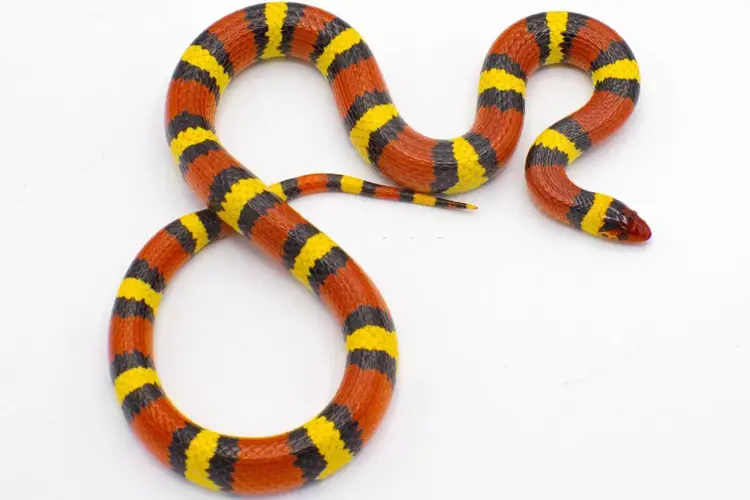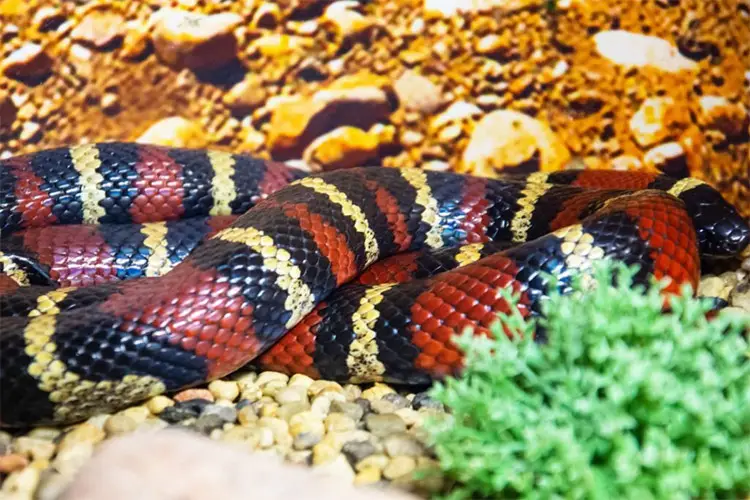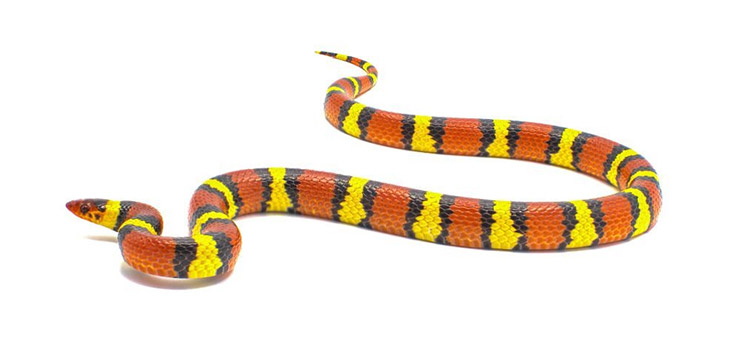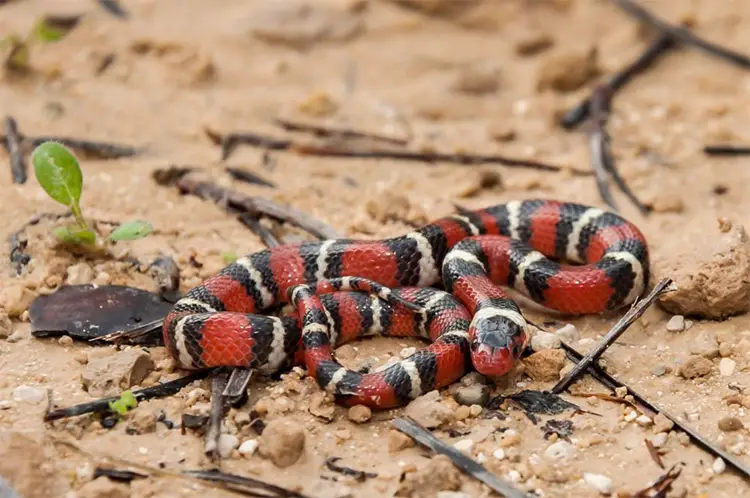It goes without saying that the scarlet kingsnake is a gorgeous reptile. With its distinct coloration and quirky attitude, it’s truly a one-of-a-kind snake. This snake is also relatively popular among seasoned snake keepers and collectors. That being said, though, is the scarlet kingsnake the right snake for you?
In today’s article, we’re tackling anything and everything that is scarlet kingsnake care-related including the snake’s temperament, feeding, enclosure requirements, environmental requirements, and much more.
| Common Name: | Scarlet Kingsnake |
| Scientific Name: | Lampropeltis elapsoides |
| Natural Habitat: | North America |
| Adult Size: | 2 to 3 feet |
| Lifespan: | 12 to 30 years |
| Diet: | Small mammals/rodents/reptiles |
| Experience Level: | Intermediate |
| Enclosure Size: | 20-gallon |
Overview
The scarlet kingsnake is a non-venomous species of snake commonly found in the Southeastern and Eastern portions of the United States. They live in areas with prairies, fields, pine-oak forests, pine flatwoods, hydric hammocks, and a variety of suburban environments, often being spotted in swimming pools during the spring months. They spend most of their time hiding and prefer to stay out of the way of humans and other snakes.
They used to be considered a species of milksnake, but have recently been re-classed into their own species category. These colorful snakes are much smaller than other species common in the pet trade and require smaller enclosures with moderate temperatures and humidity levels. Enrichment is necessary for these snakes in the form of logs, branches, leaves, and hides.
Typically, scarlet kingsnakes prefer a diet of small reptiles, but can and often are fed diets of small mammals and rodents in captivity.
Depending on the individual snake, these snakes are known for being both peaceful and calm and a bit more hot-headed than other species, but with regular handling and association with humans, most captain scarlet kingsnakes can become docile enough to handle.
Scarlet Kingsnake Care
Appearance
Scarlet kingsnakes have expressive coloration. They have bright, contrasting colors and designs that include dots, bands, and speckles that cover the entire body.
They present a tri-colored appearance, with shades of red and black that alternate with each other via banding. Also included are yellow bands, which are designed to replicate the appearance of the venomous coral snake.
Scarlet kingsnakes who live in areas where yellow is found within their natural habitat, their yellow banding and coloration is more prominent.
The yellow is typically lighter on the bottom of the snake, getting darker as it stretches across the snake’s back. The exact shade of the yellow ranges from lemon-yellow to school bus-yellow to tangerine and apricot, which are both orange-yellow colors.
Temperament and Behavior
To truly understand how these gorgeous snakes behave, we must take a look at the areas in which they live in the wild. Scarlet kingsnakes are usually nocturnal, choosing to do most of their hunting and exploring during the nighttime hours of the day. They can also be seen roaming during the early hours of the morning.
Scarlet kingsnakes are a species of snake that would prefer to flee than to bite. They tend to only bite after providing their enemy with plenty of warning beforehand. For example, when they feel threatened they may wobble their tails and release an unpleasant aroma from the glands within them, similar to what a rattlesnake does in this situation. This is known as “musking” and is a defensive mechanism used by a number of reptiles.
When your scarlet kingsnake is eating, it is best to leave them alone and untouched. Trying to handle or otherwise disturb a scarlet kingsnake that has just eaten can result in the snake feeling threatened as it is vulnerable after just eating a meal, potentially leading to musking and/or striking.
While scarlet kingsnakes can be hot-tempered, most are fairly docile — but this, of course, depends on the individual snake in question. In most cases, scarlet kingsnakes that have been born and bred in captivity are easy to hand tame and slow to bite.

Handling
As with all snakes, scarlet kingsnakes should always be handled with care. Since scarlet kingsnakes are wild animals, it’s important to remember that your snake may feel fearful of you for quite some time — especially if they have not been handled often or are young.
When handling your snake, avoid touching its face and head unless you’re administering medication. This is especially important when you’ve just recently brought your snake home and it hasn’t had a chance to get used to you yet. Because your snake may be fearful, it’s not uncommon for the scarlet kingsnake to urinate or defecate on you while you’re handling it.
To start, handle your snake a few times a week for just a few minutes, slowly increasing the length of time in which you hold your snake. Avoid handling after feedings and be sure to wait for the bulge in your snake’s abdomen that is its meal to be gone before picking your snake up.
In addition, never pick your snake up by the tail. If you’re hesitant to handle your snake or to reach into its enclosure, opt for using a snake hook instead of grabbing its tail, as this can harm its spine.
Lifespan
Scarlet kingsnakes live, on average, 12-30 years. In the wild, this number is usually on the lower end, closer to the 12-18-year range, while in captivity, scarlet kingsnakes tend to live much longer.
Of course, the lifespan of your pet snake will be affected by how you care for them. Proper care will ensure a longer happier life in most cases, the exception being in snakes that were born with genetic issues or who may not have been properly cared for most of their life.
Enclosure
Temperature
Scarlet king snakes can handle temperatures that are slightly cooler than other snakes. Their ambient temperature should be 75 to 85 degrees Fahrenheit, with a hot spot that is a few degrees warmer.
VIVOSUN Reptile Heating Pad with Digital Thermostat
At night, you can drop your snake’s enclosure temperature to 72-73 degrees, just avoid going any lower than 70.
Galapagos Aspen Digs Shavings Bedding
Humidity
You should maintain a humidity level of 70% within your snake’s enclosure. This can be achieved by misting, using bedding that retains moisture, and using a large water dish.
Lighting
Scarlet king snakes don’t require any specialized lighting. This means that you don’t have to have UVB bulbs to keep your snake healthy. In fact, scarlet kingsnakes thrive without any extra light sources — including nighttime light bulbs.
Zoo Med Reptisun Led Terrarium Hood
Despite nighttime bulbs in colors such as red, purple, and blue being marketed as “less irritating to reptiles’ circadian rhythms and eyes”, it’s best to avoid using them. There is conflicting evidence on the topic of whether these colors disturb reptiles or not.
Size
Since scarlet kingsnakes are small snakes, they don’t require as large of an enclosure as other species do. Juveniles can live comfortably in 10-gallon aquariums or terrariums, so long as they have locking lids that the snake can’t push off and escape from.
Mature scarlet kingsnakes should be upgraded to a 20-gallon enclosure at minimum. This being said, the larger the enclosure the better! Snakes will almost always use any space you provide for them.
Enrichment
Scarlet kingsnakes can climb and will do so if you provide them with adequate space. Enrichment for their enclosures can include things like branches, vines, logs, plants, moss, caves and hides, rocks, and other decor that isn’t sharp.
To save some money, you can use sticks, branches, and logs that you’ve sourced from safe areas such as forests and private, rural properties that are free of chemical treatments and pesticides.
When you get your branches home, be sure to let them dry thoroughly and, if you can, boil or bake them in the oven to kill any pests that live inside the wood. To bake them, place them on the oven racks or a baking tray and bake them at a low temperature for several hours.
Zoo Med Labs Digital Hygrometer and Thermometer
Provide your scarlet kingsnake with a variety of places to hide. They enjoy burrowing, tunneling, and hanging out underneath wood, plants, and other debris, so feel free to add a lot of clutter when decorating the enclosure. When decorating, however, take extra care to ensure that your decor won’t fall and harm your snake if it tries to go beneath it.
Diet/Feeding
In their natural habitats, scarlet kingsnakes feed on bird eggs, rodents, and lizards. They may also eat frogs, turtle hatchlings, tadpoles, and other snakes like rat snakes, garter snakes, and smaller individuals of their own species.
If you have a reputable source for small reptiles, feel free to feed your scarlet kingsnake lizards and other small creatures — the number one favorite meal for scarlet kingsnakes is small skinks. However, if you don’t, a diet of rodents (mice, rats, gerbils, hamsters, etc.) will be just fine. The rodent or prey item you choose to feed should be as large as the widest part of your snake’s body, as a rule of thumb.
When your snake is a juvenile, feed them once per week. If they are growing particularly fast, you may choose to feed as often as every three days, but once the snake is full-grown, dial back the feeding schedule to once a week. Overfeeding can result in obesity and other health problems.
Alternatively, adult snakes could be fed every 10 days or every other week. This is up to you, as the owner, and should be a decision based on the age of your snake, the size of the prey item they’re eating, and their appetite.

Alongside food, your snake should always have a source of clean, fresh water. It may not seem like it, but snakes drink a lot more than you’d think! You can provide your snake water in a shallow dish and place it at the hot end of their enclosure. This will give them water to drink as well as boost the enclosure’s humidity as the water evaporates. Before allowing your snake to drink tap water, be sure to treat the water with a water conditioner that neutralizes chemicals and ammonia.
Your water bowl should be large enough for your snake to lay in, as scarlet kingsnakes are often found in swimming pools where they have been observed swimming.
Potential Health Issues
Mites
Snake mites are small, parasitic creatures that live on and feed off the blood of reptiles such as snakes and lizards.
They are often visible to the eye, appearing as black moving specks on and in between your snake’s scales. If not caught quickly, a small mite infestation can get out of control in less than one month, due to the incredibly short lifespan that they have, which enables them to breed early on.
Snake mites can be fatal when left untreated for too long. They can also cause anemia and dehydration.
Signs of mites include:
- Soaking in the water dish
- Visible black specks
- Redness
- Scales lifting
- Irritation
- Appetite loss
- Difficulty shedding
- Lethargy
Respiratory Infections
Snakes are prone to respiratory infections (RTIs). These infections impact their lungs and make it difficult for them to breathe. RTIs are common among snakes that live in conditions that are too humid or too hot/cold.
They are a result of fungal or bacterial growth and can be painful. When left untreated, RTIs are often fatal, as the snakes are unable to get enough oxygen into their system.
Signs of RTIS include:
- Breathing with mouth open
- Breathing heavily
- Restlessness
- Appetite loss
- Audible crackling or wheezing
Difficulty Shedding
Most common in juveniles but able to affect snakes of all ages, difficulty shedding is a regular problem among snakes. It is often found affecting snakes that are dehydrated or who don’t live in a climate that is humid enough for their needs.
For this reason alone, it’s a good idea to boost your snake’s humidity temporarily while they are going through the shedding process.
Difficulty shedding shouldn’t be a cause for panic. However, the condition should be monitored. If a second shed comes and goes and the stuck shed remains, it’s necessary to bring your snake to an exotic vet for treatment. Stuck shed can cause blindness if the area includes the eyecaps, while stuck shed building up on the tail tips can cause the tip of the tail to lose blood flow and fall off.
Galápagos Terrarium Sphagnum Moss
You can help your snake with its stuck shed at home by giving it a bath, providing a humid hide, by boosting humidity in the enclosure, and by wetting your snake with warm water and gently rubbing the shed off. Do not pull stuck shed off — this can damage the scales of the snake and cause wounds.
Signs of difficult shedding include:
- Pieces of shed stuck on snake
- Shed that comes off in fragments
Constipation
Snake constipation is the exact same thing as it is for humans. This condition is what happens when the bowels start moving very slowly or stop moving at all. It can be a result of dehydration or of overfeeding.
Luckily, it can be managed at home in many cases. Management entails giving your snake a warm bath and allowing them to essentially slither around in the warm water, which will often stimulate the bowels and cause them to release.
To prevent constipation, make sure that your snake always has an abundance of water available to them. Also, monitor your snake’s defecation — ie, make sure your snake defecates in between feedings. If your snake doesn’t defecate between two feedings, it may not be a cause for concern but if more than two feedings go by with no defecation, it’s time to check your snake for constipation.
Signs of constipation can include:
- Bloating
- Lethargy
- Loss of appetite
- Lack of noticeable bowel movements
- Aggression

Breeding
Scarlet kingsnake breeding seasons are dependent on the geographical region in which the snake lives. In colder climates, reproduction happens around late spring, while, in warmer climates, scarlet kingsnakes may begin breeding in early spring. Sexual maturity is reached around the two-year mark.
Scarlet kingsnakes lay eggs — typically two to twelve per clutch. These eggs hatch within two months after being laid, and the young look like miniature versions of adults.
Scarlet Kingsnake FAQs
Scarlet kingsnakes, unlike their lookalikes the coral snake, are not venomous. If bitten by a scarlet kingsnake, you will not have a negative reaction aside from localized pain at the site of the bite.
Scarlet snakes and scarlet kingsnakes look very similar. In fact, if you didn’t know how to distinguish between the two, you’d probably get them mixed up. The easiest way to tell them apart is based on their band colors — the scarlet snake’s bands don’t completely encircle the body the way the scarlet king snakes do.
Scarlet kingsnakes and milksnakes are different subspecies, or races, of the same snake. That being said, they are different snakes.
The easiest way to tell the two apart is based on their colors. Scarlet kingsnakes will have bands in this order: red, black, yellow, black, red, while coral snakes will have this order: red, yellow, black, yellow and red.
In general, scarlet kingsnakes are incredibly passive snakes. There can be the odd individual who is more aggressive, though.
Scarlet kingsnakes are semi-arboreal, meaning they spend most of their time on the ground but can and do climb trees.
Conclusion
Scarlet kingsnakes, for the most part, make great pets. They are relatively docile and easy to take care of. In addition, they have striking colors and can stand as the focal point of any room that they’re placed in.
If you’re considering getting a scarlet kingsnake or have recently acquired your first one, we hope that this in-depth article has been of value to you and that you love your scarlet kingsnake just as much as love ours!
Other Kingsnakes:








